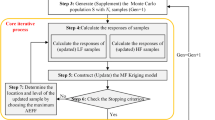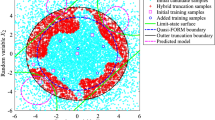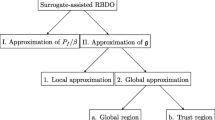Abstract
An improved reliability method, i.e., AL-AS-GPR-MCS, is developed taking advantage of active subspace (AS)-based dimension reduction technique, Gaussian process regression (GPR) surrogate model, active learning (AL)-based sampling strategy, and Monte Carlo simulation (MCS). In this method, the AL sampling strategy and the AS-based dimension reduction are incorporated into the GPR construction, allowing that the newly added sample in each iteration can be employed simultaneously to update the identified AS of original high-dimensional space and to refine the low-dimensional GPR model over the discovered AS. The failure probability is then estimated by the MCS using the constructed GPR model. In order to verify the versatility of the proposed method, four numerical examples are investigated, involving reliability analyses of both explicit performance functions and shear frame structures with implicit performance functions. It is revealed that satisfactory accuracy enhancement and computational cost savings are achieved by the AL-AS-GPR-MCS, since it is capable of discovering the latent AS of the original high-dimensional space which alleviates the curse of dimensionality, and refining the low-dimensional GPR construction within the discovered AS by the AL sampling strategy. Therefore, the proposed method is a powerful and promising tool for dealing with structural reliability problems with strong nonlinearities and high stochastic dimensions.











Similar content being viewed by others
References
Aas K, Czado C, Frigessi A, Bakken H (2009) Pair-copula constructions of multiple dependence. Insur Math Econ 44:182–198
Au SK, Beck JL (2001) Estimation of small failure probabilities in high dimensions by subset simulation. Probab Eng Mech 16(4):263–277
Bect J, Ginsbourger D, Li L, Picheny V, Vazquez E (2012) Sequential design of computer experiments for the estimation of a probability of failure. Stat Comput 22(3):773–793
Bellman RE, Dreyfus SE (2015) Applied dynamic programming. Princeton university press
Bichon BJ, Eldred MS, Swiler LP, Mahadevan S, McFarland JM (2008) Efficient global reliability analysis for nonlinear implicit performance functions. AIAA J 46(10):2459–2468
Coleman KD, Lewis A, Smith RC, Williams B, Morri M, Khuwaileh B (2019) Gradient-free construction of active subspaces for dimension reduction in complex models with applications to neutronics. SIAM/ASA J Uncertain Quantif 7(1):117–142
Constantine PG, Dow E, Wang Q (2014) Active subspace methods in theory and practice: applications to kriging surfaces. SIAM J Sci Comput 36(4):A1500–A1524
Constantine PG, Emory M, Larsson J, Iaccarino G (2015) Exploiting active subspaces to quantify uncertainty in the numerical simulation of the HyShot II scramjet. J Comput Phys 302:1–20
Deng J, Gu D, Li X, Yue ZQ (2005) Structural reliability analysis for implicit performance functions using artificial neural network. Struct Saf 27(1):25–48
Der Kiureghian A, Dakessian T (1998) Multiple design points in first and second-order reliability. Struct Saf 20(1):37–49
Ditlevsen O, Madsen HO (1996) Structural reliability methods. Wiley, New York
Echard B, Gayton N, Lemaire M (2011) AK-MCS: an active learning reliability method combining Kriging and Monte Carlo simulation. Struct Saf 33(2):145–154
Echard B, Gayton N, Lemaire M, Relun N (2013) A combined importance sampling and Kriging reliability method for small failure probabilities with time-demanding numerical models. Reliab Eng Syst Saf 111:232–240
Engelund S, Rackwitz R (1993) A benchmark study on importance sampling techniques in structural reliability. Struct Saf 12(4):255–276
Goodhue DL, Lewis W, Thompson R (2012) Does PLS have advantages for small sample size or non-normal data? MIS Quart Manage Inf Syst 36:981–1001
Guimarães H, Matos JC, Henriques AA (2018) An innovative adaptive sparse response surface method for structural reliability analysis. Struct Saf 73:12–28
Hino H, Wakayama K, Murata N (2013) Entropy-based sliced inverse regression. Comput Stat Data Anal 67:105–114
Huang X, Chen J, Zhu H (2016) Assessing small failure probabilities by AK-SS: an active learning method combining Kriging and Subset Simulation. Struct Saf 59:86–95
Jiang Z, Li J (2017) High dimensional structural reliability with dimension reduction. Struct Saf 69:35–46
Kaymaz I (2005) Application of kriging method to structural reliability problems. Struct Saf 27(2):133–151
Kroetz HM, Tessari RK, Beck AT (2017) Performance of global metamodeling techniques in solution of structural reliability problems. Adv Eng Softw 114:394–404
Lewis A, Smith R, Williams B (2016) Gradient free active subspace construction using Morris screening elementary effects. Comput Math Appl 72(6):1603–1615
Li J (2015) Probability density evolution method: background, significance and recent developments. Probab Eng Mech 44:111–117
Li J, Chen J (2009) Stochastic dynamics of structures. John Wiley & Sons
Li B, Wang S (2007) On directional regression for dimension reduction. J Am Stat Assoc 102:997–1008
Li M, Wang Z (2019) Deep learning for high-dimensional reliability analysis. Mech Syst Signal Process. https://doi.org/10.1016/j.ymssp.2019.106399
Li J, Chen J, Sun W, Peng Y (2012) Advances of the probability density evolution method for nonlinear stochastic systems. Probab Eng Mech 28:132–142
Li W, Lin G, Li B (2016) Inverse regression-based uncertainty quantification algorithms for high-dimensional models: theory and practice. J Comput Phys 321:259–278
Li DQ, Zheng D, Cao ZJ, Tang XS, Qi XH (2019) Two-stage dimension reduction method for meta-model based slope reliability analysis in spatially variable soils. Struct Saf 81:101872
Liu H, Ong YS, Cai J (2018) A survey of adaptive sampling for global metamodeling in support of simulation-based complex engineering design. Struct Mutltidiscip Opt 57(1):393–416
Ma F, Zhang H, Bockstedte A, Foliente GC, Paevere P (2004) Parameter analysis of the differential model of hysteresis. J Appl Mech Trans ASME 71(3):342–349
Nelsen RB (2007) An introduction to copulas. Springer Science & Business Media
Pan Q, Dias D (2017) An efficient reliability method combining adaptive support vector machine and Monte Carlo simulation. Struct Saf 67:85–95
Peng Y, Ghanem R, Li J (2013) Generalized optimal control policy for stochastic optimal control of structures. Structural Control and Health Monitoring, 20:67–89
Plessix RE (2006) A review of the adjoint-state method for computing the gradient of a functional with geophysical applications. Geophys J Int 167(2):495–503
Rackwitz R (2001) Reliability analysis-a review and some perspective. Struct Saf 23(4):365–395
Saltelli A, Ratto M, Andres T, Campolongo F, Cariboni J, Gatelli D et al (2008) Global sensitivity analysis: the primer. John Wiley & Sons
Seila AF (1982) Simulation and the Monte Carlo method. Taylor & Francis
Su G, Peng L, Hu L (2017) A Gaussian process-based dynamic surrogate model for complex engineering structural reliability analysis. Struct Saf 68:97–109
Tripathy R, Bilionis I, Gonzalez M (2016) Gaussian processes with built-in dimensionality reduction: applications to high-dimensional uncertainty propagation. J Comput Phys 321:191–223
Wen Z, Yin W (2013) A feasible method for optimization with orthogonality constraints. Math Program 142(1–2):397–434
Williams CK, Rasmussen CE (2006) Gaussian processes for machine learning. MIT press Cambridge, MA
Wold S, Sjöström M, Eriksson L (2001) PLS-regression: a basic tool of chemometrics. Chemometr Intell Lab Syst 58(2):109–130
Xiu D, Em Karniadakis G (2003) The Wiener-Askey polynomial chaos for stochastic differential equations. SIAM J Sci Comput 24(2):619–644
Xu J, Wang D (2019) Structural reliability analysis based on polynomial chaos, Voronoi cells and dimension reduction technique. Reliab Eng Syst Saf 185:329–340
Xu J, Zhu S (2019) An efficient approach for high-dimensional structural reliability analysis. Mech Syst Signal Process 122:152–170
Zhang X, Pandey MD (2013) Structural reliability analysis based on the concepts of entropy, fractional moment and dimensional reduction method. Struct Saf 43:28–40
Zhao YG, Ono T (2001) Moment methods for structural reliability. Struct Saf 23(1):47–75
Zhou T, Li AQ (2019) Seismic fragility assessment of highway bridges using D-vine copulas. Bull Earthquake Engin 17:927–955
Zhou T, Peng Y (2020) Adaptive Bayesian quadrature based statistical moments estimation for structural reliability analysis. Reliab Eng Syst Saf 198:106902
Zhou T, Li AQ, Wu YF (2018) Copula-based seismic fragility assessment of base-isolated structures under near-fault forward-directivity ground motions. Bull Earthq Eng 16:5671–5696
Zhou T, Peng Y, Li J (2019) An efficient reliability method combining adaptive global metamodel and probability density evolution method. Mech Syst Signal Process 131:592–616
Funding
The supports of the National Key R&D Program of China (Grant No. 2017YFC0803300), the National Natural Science Foundation of China (Grant Nos. 51678450, 51878505, and 51725804), the Committee of Science and Technology of Shanghai China (Grant No. 18160712800), and the Ministry of Science and Technology of China (Grant No. SLDRCE19-B-26) are highly appreciated.
Author information
Authors and Affiliations
Corresponding author
Ethics declarations
Conflict of interest
The authors declare that they have no conflict of interest.
Replication of results
The details of the proposed methodology and of the specific values of the parameters considered have been provided in the paper. Hence, we are confident that the results can be reproduced. Readers interested in the source code are encouraged to contact the authors by e-mail.
Additional information
Responsible Editor: Xiaoping Du
Publisher’s note
Springer Nature remains neutral with regard to jurisdictional claims in published maps and institutional affiliations.
Rights and permissions
About this article
Cite this article
Zhou, T., Peng, Y. Structural reliability analysis via dimension reduction, adaptive sampling, and Monte Carlo simulation. Struct Multidisc Optim 62, 2629–2651 (2020). https://doi.org/10.1007/s00158-020-02633-0
Received:
Revised:
Accepted:
Published:
Issue Date:
DOI: https://doi.org/10.1007/s00158-020-02633-0




